Menu

Did you know using different crops together can make soil 25% healthier? This is just one way seasonal farming helps the land. By changing what we grow each year, farms can get more food and last longer.
Seasonal farming uses many smart methods. It mixes different crops, covers the soil, and doesn’t plough too much. These ways help the earth stay strong and let growers use less energy and chemicals.
These methods are about more than growing crops. They look after the whole farm, from the soil to the plants and animals. This approach is key as the world needs more food. We must find sustainable ways to farm that keep our planet healthy.
Seasonal farming is deeply linked to nature’s cycles, making it vital to adapt to change. With each season offering different tasks, the fall becomes very busy with harvest starting in mid-September. This adaptability in farming sets the pace for the year’s work and supports sustainability.
Adapting to seasons is essential in keeping farms efficient and sustainable. For example, fall tillage, a practice at Vandenberg Farms, boosts soil fertility. Winter, on the other hand, is a time to rest after harvest, allowing farmers to prepare for planting with better machinery and plans.
This careful management of farming seasons helps save resources and boosts output.
Seasonal farming’s roots go back to ancient times, aligning with natural patterns. But today, things like climate change and growing populations need new solutions. Sustainable farming aims to reduce pollution, keep soil fertile, and help local economies. For example, spring sees the start of planting and the crucial use of herbicides and pesticides for healthy crops.
Summer is key for applying nutrients and dealing with pests, needing just the right rainfall. This highlights the need for close watch and quick, smart responses to protect harvests. The ongoing need for adjustment to seasons in farming shows its key role.
| Season | Activities | Challenges |
|---|---|---|
| Fall | Harvest, fall tillage | Managing large tasks, grain bin overflow risks |
| Winter | Machinery maintenance, strategic planning | Weather constraints, resource management |
| Spring | Crop planting, application of herbicides/pesticides | Ensuring timely operations, resource allocation |
| Summer | Applying fertilisers, weather management | Variable rainfall affecting crop health |
Surviving these evolving challenges needs seasonal farming entrenched in agriculture. Following guidelines from organisations like the FAO can build resilience in nature. This ensures food security and promotes sustainable farming.
Agriculture cycles show how seasonal changes affect crop yields. Every season has its farming challenges, requiring precise seasonal crop management. It’s vital to adapt strategies to local conditions, which vary from harsh winters to scorching summers. Understanding the interplay of factors across seasons is key.
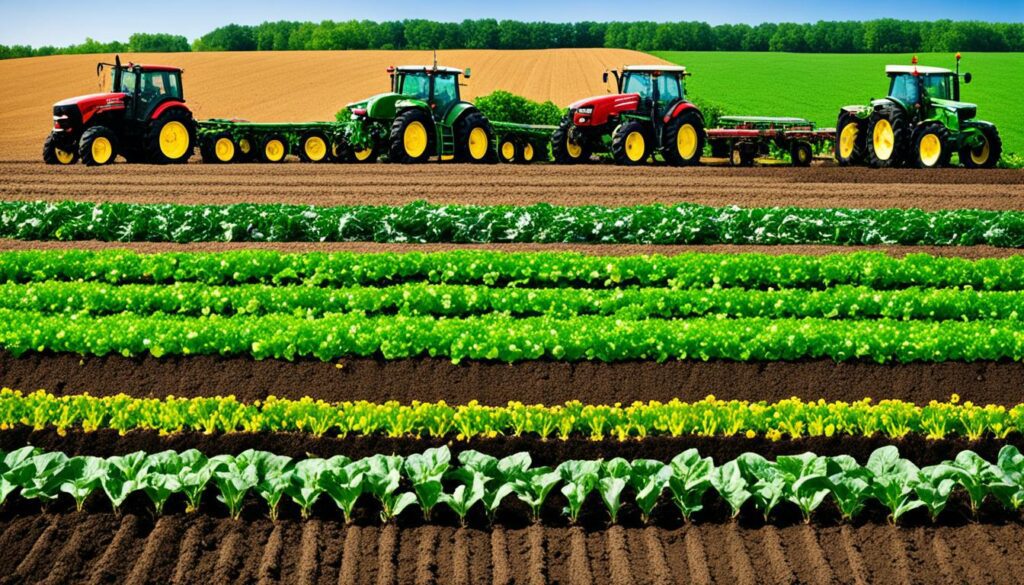
Each farming season brings different challenges and chances. Winters involve keeping soil health for spring planting. This can include planting cover crops. Spring needs careful planting timing for the best growth. Summers require strong irrigation and pest control against heat and drought. Autumn is about efficient harvests to prepare for the off-season.
Crop rotation cycles can last up to eight years, showing the need for long-term plans. Rotating crops can improve soil health and boost yields. It helps reduce risks in production too.
Adapting to local farming conditions is crucial. It includes adjusting agriculture cycles to fit the local climate and soil. For drier areas, using drought-resistant plants may be necessary. Wetter regions could benefit from better drainage. Seasonal crop management also involves matching sowing dates with local weather and using water wisely.
Crop rotation helps the environment by cutting down on synthetic chemicals. It also boosts weed control and water use by improving the soil. Projections show that warmer temperatures could change productivity. Adaptable agriculture cycles are a must.
| Challenge | Solution |
|---|---|
| Winter Soil Health | Use of cover crops to prevent erosion and maintain fertility |
| Spring Planting | Adjust sowing dates to optimise growth |
| Summer Drought | Implementing robust irrigation systems |
| Autumn Harvest | Efficient crop collection and soil preparation |
Thriving through seasonal farming challenges comes from understanding each season’s needs. Meeting these needs enhances crop yields and promotes environmental health. This leads to sustainable farming in the long run.
Crop rotation is key to sustainable farming. It helps in many ways, not just boosting harvests. By changing crops, we can improve soil and its nutrients. This way, farms meet USDA Organic Rules. Using different crops keeps the soil healthy and controls pests well. It also helps farms to be more economically stable.
Crop rotation fights soil loss, cutting the need for harmful chemicals by 20% to 40%. It also helps manage pests and weeds better, making a wider variety of crops possible. With this method, soil erosion can drop by up to 80%, and more plants and animals can live there.
Mixing crop rotation with no-till or low-till is even better for the earth. Doing so can boost the amount of carbon in the soil by 0.3% to 0.7% each year. It can also bring down greenhouse gas emissions and improve soil health by half.
Good crop rotation plans look at how to keep the soil healthy as things change. For example, growing nitrogen-fixing crops like clover with cash crops helps the soil. It reduces weeds naturally and prevents soil loss.
In some places, moving where cover crops are grown helps keep the area healthy and stops too many pests. Vineyards might do this to make their land easier to use and to protect against frost. Such planning makes farming greener and more long-lasting.
Mixing different plants within crop rotations also uses the land well and boosts the number of living things there. This not only grows more food but cuts down on chemical fertilisers. Over time, it can mean using 25% to 30% fewer chemicals.
“I have witnessed firsthand how crop rotation revitalises the soil, making it more robust and fertile season after season. This sustainable farming practice bridges productivity with environmental stewardship,” affirms a seasoned organic farmer.
Such stories show how important crop rotation is for keeping farms going in a good way. Using this method helps farms and the environment. It also supports the goal of making agriculture more durable and healthy.
Planting calendars are key for big harvests. They account for different farming conditions and when seasons change. For farmers, they show the best times to plant and harvest, making planning easier.
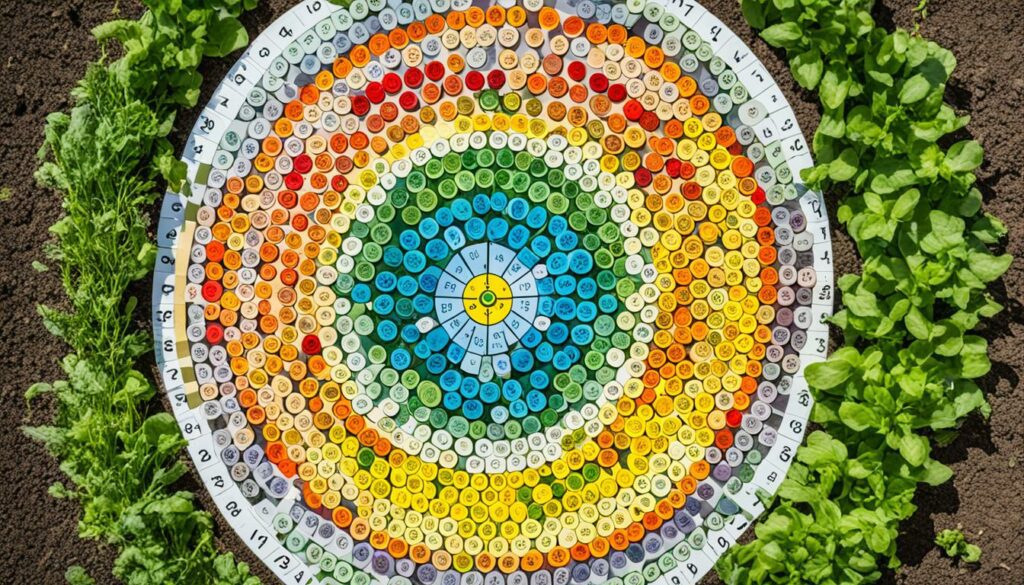
To create a good planting calendar, knowing the local climate is crucial. Research shows planting soybeans just 12 days earlier can raise yields by 10%. In places like Nebraska, Illinois, and Wisconsin, farmers who plant at the right times enjoy the best outcomes.
Even small changes in planting times can make a big difference. For Iowa and Ohio, planting a little earlier could have increased their crops by a lot. This shows how important precise planning with these calendars can be.
Regional differences are a big part of these planting calendars. Places in the Southeast might need to start planting earlier to get the most from the season. Equally, spots like Minnesota, North Carolina, and Kansas could see a big jump in earnings just by changing their planting times slightly.
From 2007 to 2016, if everyone in farming had adjusted their planting a little, the extra money from crops could have been really huge. This proves the value of personalised, regional planting calendars.
By including regional details and timing with planting calendars, farmers can aim for better harvests. These tools help in knowing the best time to do farm work. They are crucial in achieving more crops regardless of the type of farm.
Working with weather-dependent cultivation means farmers must change their plans to match the weather. Studies predict a big 17% drop in how much food we can grow by 2050 because of climate change. So, updating farming methods is more important than ever. For example, adding fertiliser to pastures every four to five years helps them keep growing well.
Hotter weather might mean that less land is good for growing coffee in Brazil. But, farmers can adapt by using the best farming methods at the right times. One smart way is through integrated farming, which can make the land cooler and wetter. Using agroforestry helps, too. It makes the soil better, attracts helpful insects, and makes the area more diverse.
In the US, farming plays a big part in the economy, bringing in more than $300 billion a year. But, bad weather can really hurt this. In 2011, heat waves from climate change cost over $1 billion in farming losses. This is why it’s crucial that farmers use methods that can face these challenges and still produce food.
Smart agriculture cycles can help fix damaged pastures and make keeping animals more sustainable. Planting trees and managing forests well not only helps farms be stronger but also stops forest fires. This is important for the 21 million hectares of Brazilian forests that need help fast.
Now, let’s look closely at how different farming methods work, especially when it comes to the weather:
| Strategy | Impact on Productivity | Environmental Benefit |
|---|---|---|
| Drought Management Systems | Mitigates yield loss during dry spells | Preserves water resources |
| Moisture Conservation Techniques | Enhances crop growth in wet seasons | Reduces soil erosion |
| Agroforestry | Boosts overall farm productivity | Improves biodiversity, soil, and water health |
| Rotational Grazing | Supports sustainable livestock management | Mitigates methane emissions |
By using these sustainable farming methods, farmers can handle different weather challenges. And, they help make farming better for the environment. These methods keep farming strong and earth-friendly, even with changing weather.
Cover crops are key to sustainable farming. They offer a range of benefits that improve soil health. This makes them crucial during off-seasons for preventing erosion and keeping soil fertile. They are a big part of taking care of the land for the future.
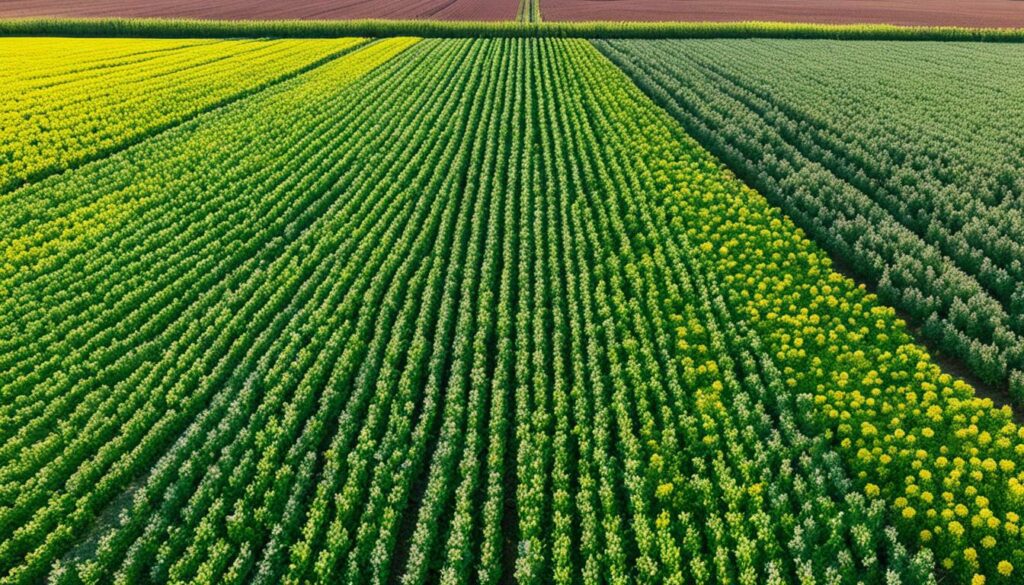
Various cover crops help meet different farming needs:
Research has shown a lot of good coming from these crops. For example, from 2012 to 2017, eight states greatly increased their use of cover crops. Also, more farms started using them, with a 15.2% jump. Studies from Clemson University found that organic kale, grown after legume cover crops, had more nutrients and higher yields than usual.
To get the most out of cover crops, farmers should plan carefully. They should think about when to plant and which types go best with the next cash crops. Using cover crops well can help manage soil nutrients and keep pests at bay effectively.
| Statistic | Details |
|---|---|
| Acreage Increase (2012-2017) | 50% increase, with 15.4 million acres in 2017 |
| Farms Implementing Cover Crops | 15.2% rise from 2012 to 2017 |
| Nebraska Impact | Program reached over 8,500 individuals, affecting 2.8 million acres |
| Research Findings | Higher nutrient levels and yields in organic kale following legume cover cropping |
Handy tools like the Whole Farm Mass Nutrient Balance and Cover Crop Economics Calculators from the University of Vermont Extension are great helps. They let farmers check nutrient use and finances to get the best from cover crops for eco-friendly farming.
Sustainable farming is important all year, but we need different strategies for each season. These methods help keep the soil healthy, increase produce, and preserve nature’s balance.
In spring, we start by saving water and planting smart. Using drip irrigation and fertilising correctly are key. Cover crops and a variety of plants help control pests and keep the soil good.
Summer gets hot, so protecting crops from the heat is vital. Planting in the shade and covering the ground with mulch helps keep moisture in. Changing the crop locations also helps maintain the soil’s nutrients.
As autumn comes and it gets cooler, we focus on keeping the soil healthy. Mulching and planting cover crops stop nutrients from washing away. Adding livestock after harvest helps enrich the soil with natural fertiliser.
Winter is about getting the land ready for the next growing season. Using green manures and cover crops keeps the soil from eroding and adds nutrients back. It’s also a good time to reduce how much we till, keeping the soil and its life healthy.
Using these methods all year round keeps farming productive and kind to the environment. Each season has its challenges and chances to do better for the earth and our crops.
| Season | Key Practices | Benefits |
|---|---|---|
| Spring | Water conservation, high biodiversity, strategic planting | Improved soil structure, pest control, enhanced growth |
| Summer | Heat stress management, shaded cropping, mulching | Retained soil moisture, balanced soil nutrients |
| Autumn | Soil preservation, mulching, cover crops, integrating livestock | Prevents nutrient leaching, enhances soil fertility |
| Winter | Green manures, cover crops, reduced tillage | Maintains soil integrity, promotes nutrient enrichment |
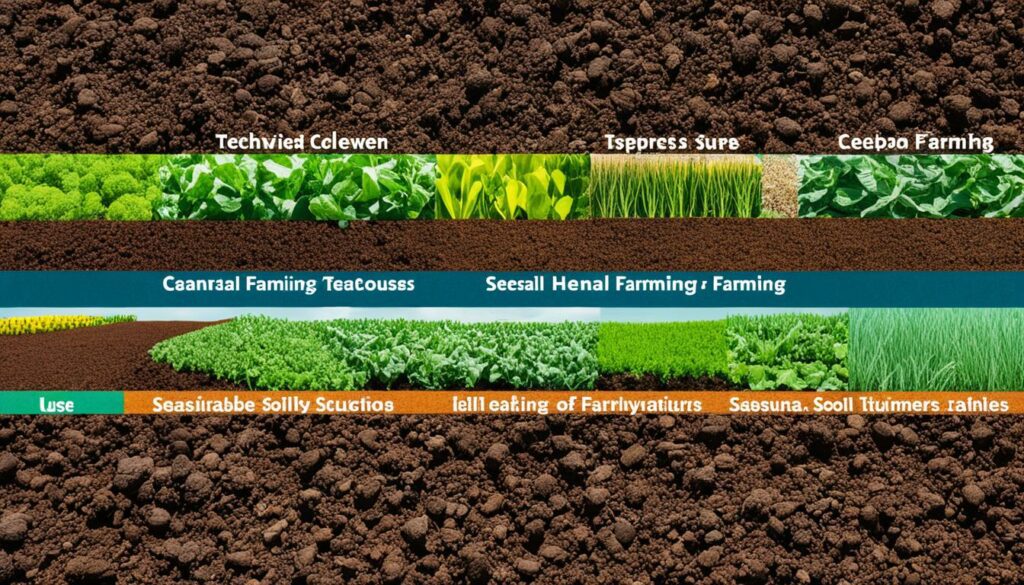
Keeping soil healthy is key to growing crops year after year. With soil often blown or washed away, farmers must use smart strategies. This includes planting at the right times and using special barriers like windbreaks and keeping the soil untilled where possible. These methods stop the soil from wearing away and help the land become a better home for animals and plants.
One way to keep soil in place is by planting cover crops. These not only stop soil from being lost but also keep nutrients from running off and prevent weeds. Some plants, like peas and beans, help other plants grow better by adding nutrients to the soil. There are ways to get rid of these crops without digging the soil, which keeps it healthier and home to more kinds of living things.
Changing which crops are grown where is also a big help. It reduces the need for chemicals, keeps soil where it should be, and makes water cleaner. Mixing in crops used for feeding animals can make the land even better and give homes to different types of wildlife. Plus, leaving the soil untilled between these crops helps the soil soak up water and keeps the water clean.
“Keeping the ground covered with different plants, especially in areas where crops come back every year, helps good bugs live there and makes the whole system work better.”
Putting special plants between the main crops is good for birds and insects. Managing what nutrients go in the soil makes crops need less care and protects the water. Sometimes, burning or letting animals graze can make the land healthier by getting rid of plants that don’t belong and improving what grows there.
Planting trees and bushes can also protect the soil, the air, and the water. By doing all these things throughout the year, farms can stay productive and support a rich variety of life.
| Practice | Benefits |
|---|---|
| Cover Crops | Control erosion, suppress weeds, improve soil fertility |
| No-till/Reduced-tillage | Prevent erosion, reduce compaction, improve habitat |
| Crop Rotation | Reduce erosion, pesticide costs, improve water quality |
| Prescribed Grazing/Burning | Enhance species composition, forage quality, manage vegetation |
| Windbreaks | Reduce wind velocity, protect soil |
Integrated pest management (IPM) is key in sustainable farming. It cuts down on chemicals and fits sustainable farming well.
Different seasons need different ways to manage pests. In spring, using bugs that eat pests keeps their numbers down. Summer means using covers and traps to stop pests getting to plants.
Autumn brings the need for changing where crops grow. This disrupts pests and stops their numbers growing. It also helps the soil stay healthy. In winter, plants that attract pests away from main crops can save the day.
IPM keeps workers safe from chemicals and helps the environment by cutting pollution. (Source: Benefits of IPM, County of Santa Clara.)
IPM uses many ways to deal with pests – from natural to using some chemicals. This way is good for pest control and the planet.
| Season | Control Method | Benefits |
|---|---|---|
| Spring | Biological Control (Predatory Insects) | Maintain pest populations, enhance soil fertility |
| Summer | Mechanical Methods (Row Covers, Traps) | Physical pest barriers, reduced crop damage |
| Autumn | Cultural Methods (Crop Rotation) | Disrupt pest life cycles, maintain soil health |
| Winter | Trap Plants | Divert pests from main crops, protect yield |
IPM makes plants stronger and better at fighting off bugs. It helps keep the natural balance and is good for the farm and the earth.
Treating soil well in IPM means healthier plants. They resist bugs more naturally. (Source: Benefits of IPM, County of Santa Clara.)
Using IPM makes farm plants tough and helps the planet. It brings farming and nature closer, showing a way to farm sustainably.
Integrating livestock with crops is key to sustainable farming. It offers many benefits beyond just farming. For example, a 1908 study showed adding dairy farming to growing forage can improve poor soil fast. This shows the great potential of combining farming methods.
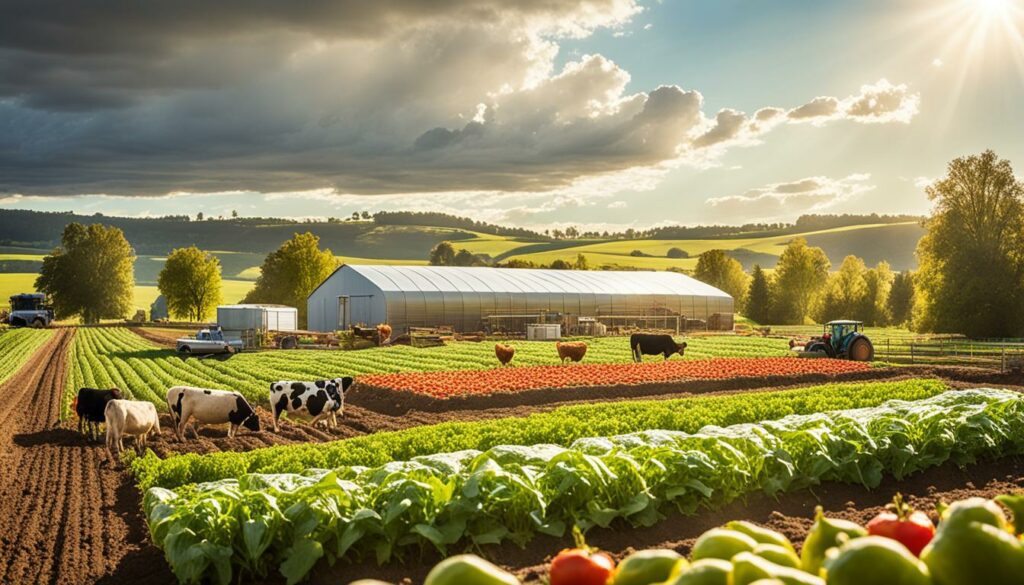
Adding livestock to crop farms improves how nutrients move around. For instance, manure from animals is worth about $25 billion in the U.S. It’s rich in nitrogen, phosphorus, and potassium. These nutrients help the soil a lot, making it better for growing. This is important because using land only for growing grains without livestock can harm the soil.
In the U.S., many livestock farms import their animal feed. This can lead to too many nutrients in one place. And when there’s too much water, like during a hurricane, this can pollute the environment. For a healthier system, we need to balance out these nutrients. This is why mixing livestock with crops is better for the environment.
Managing farms through the different seasons is important. For example, using cover crops can help the soil and feed animals. This helps complete the cycle of managing nutrients. It has been found that using cover crops can make growing corn and soybeans more profitable. This shows that these methods are not just good for the environment, they are good for business too.
Integrating livestock with crops can bring in more money. For example, in Indonesia, such farming increased profits by over 136% in three years. This approach also works well in the Philippines, Thailand, and Bangladesh. In Africa, it helps food grow better and keeps the environment healthy. These farming systems have positive effects worldwide.
Ghana in West Africa shows how powerful this integrated farming can be. There, combining crops and animals has increased farm income. In India’s Tamil Nadu, an advanced farming model includes crops, dairy, and more. It serves as a good example of sustainable farming. A survey of 150 farmers showed this method worked better than traditional practices.
Mixing livestock with crops changes farming for the better. It’s about creating a system that works with nature for a long time. This way of farming leads to a future where agriculture and the environment are in harmony. It’s all about sustainable and resilient farming practices.
Agroforestry mixes trees and shrubs with farm land, boosting ecological and economic wins. It backs sustainable farm systems and improves seasonal farming. This deals with making farms more productive while also being mindful of the environment.
Adding trees and shrubs to farms has lots of perks. It ups the farm’s food supply and cuts down on greenhouse gases from making fodder by a lot. For the years 2020-2050, these systems could lessen CO2 emissions greatly. Agroforestry also helps economically by cutting down costs to control these emissions.
Agroforestry also boosts crop output by keeping soil rich and reducing nutrient loss. This means less need to cut down forests and keeps up the good quality of food for animals in a hotter world. So, we get wins for food supply and the health of the planet.
These systems use trees as wind blockers, which can up soy and corn crops. It also keeps the soil the right temperature, holds on to moisture, and gives shelter. This stops animals from getting too hot and helps farming to cope better with climate change.
Creating these systems needs a smart choice of trees and how they’re placed. Planting must match the farming season. This makes sure everything grows well together.
Teaching farmers about agroforestry is key to its success. Programs, both face-to-face and online, show how it works and the benefits. Governments should help by making farming land secure and offering rewards for looking after the environment this way.
Pakistan’s Billion Trees Afforestation Project (BTAP) is a great example. Millions of trees have been given out to farmers for their own land. This project has made a big difference in making farming more sustainable and helping rural areas.
Timely adoption of agroforestry practices can bring big benefits. But, in some places like the Hindu Kush Himalayas, there are hurdles like politics and land rights. Yet, things like age, education, and working together can make a big difference in getting more farmers to adopt these ways. This would be good for farmers, those leading the projects, and the planet.
To manage a whole farm well, a farmer needs to look at the big picture. This means thinking about the farm as a whole, not just separate parts. When they plan their work for each season, they can both grow food and protect the environment. They learn how everything on the farm connects, from crops to animals to the land itself, to be truly sustainable.
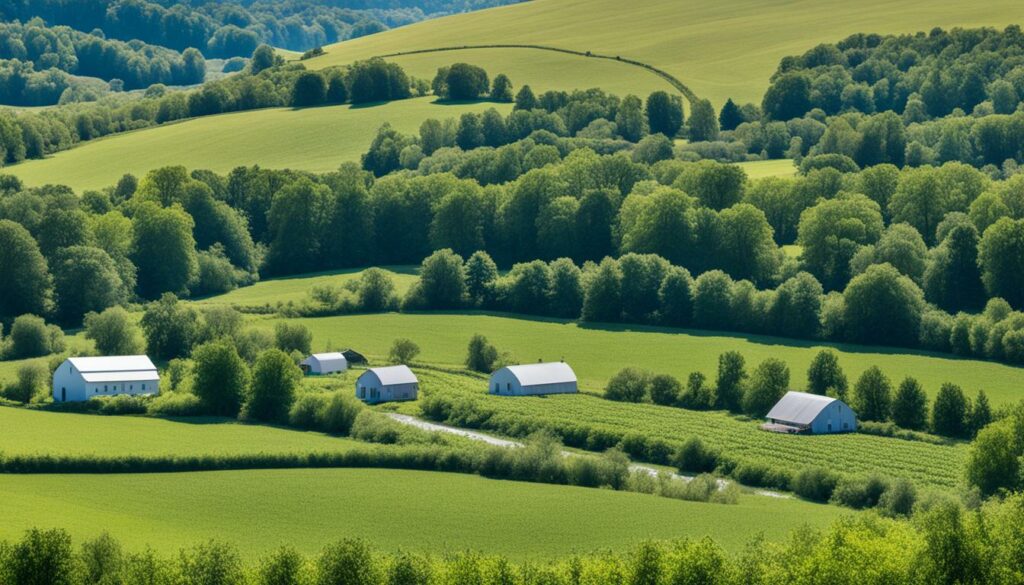
Seasonal management involves using farm practices that work with nature. You might see farmers leaving strips of plants along streams. These are riparian buffers and they help birds and deer find places to live.
Farmers also handle their manure carefully to keep the soil healthy. This also meets laws that stop water pollution. In places like Pennsylvania, these rules help keep the environment safe.
It’s also really important for farmers to do things like plant and harvest crops at the right time. If they don’t, they might not get as much food from their fields. Some farmers close to cities, like in San Francisco, use smart ways to farm. They change what they grow and how they grow it through the year. This shows how farm plans can help the environment and make the farm work better.
Looking at real farms can teach us a lot about good farming. In Pennsylvania, farms that focus on just a few things can make a lot of money. This is because they use technology and marketing well. They help the local area more than they use local services, thanks to laws protecting their work.
Some farms let their animals roam in a way that’s like wild animals moving through the land. This helps the land stay healthy. They get help from programmes that care for wildlife. This way, farms can be good homes for many plants and animals.
| Indicator | Traditional Farm | Holistically Managed Farm |
|---|---|---|
| Revenue Contribution | Limited | Significant |
| Manure Management | Basic | Comprehensive, Regulatory-Compliant |
| Biodiversity Support | Minimal | Inclusive of Natural Habitats |
| Seasonal Farming Activities | Standard Practices | Adaptive Management |
Stories of these farms show us how to farm in really smart ways. By looking at these examples, we can learn how to make farms better for the environment. Good farming can make farms last a long time and stay healthy alongside nature.
Seasonal farming in the United States is critical for good harvests. It matches the different climates across the country. It involves using the right methods at the right times through the year.
Here’s a picture of seasonal farming practices:
In the winter, from December to February, farmers get a break. They fix and upgrade their machines for the coming spring. This is key to being ready for the new growing season.
Spring, from March to June, is when things really pick up. Farmers plant their crops and guard them against pests. This work lays the groundwork for successful growth.
From July to early September, summer is about keeping the crops healthy. This means using fertilisers and pesticides. It’s also the time when rain, or lack of it, can make a big difference to the harvest. So, farmers must be ready to adjust their plans.
Cover crops are used throughout the year to protect the soil and foster good growing conditions. They help stop soil erosion and keep weeds away. This makes for better crops and helps the environment. But, it can be hard to grow these and still get good main crop yields without help from the government.
For farming to be sustainable, more research and new ideas are essential. It’s important for farmers and those who make the rules to work together. This way, they can use the best ways to grow food without harming the environment.
| Season | Primary Activities | Challenges |
|---|---|---|
| Fall (Mid-September) | Harvest, Fall Tillage | Soil Preparation, Organic Matter Enhancement |
| Winter (Dec-Feb) | Rest, Equipment Maintenance | Minimal Activity, Planning for Spring |
| Spring (Mar-June) | Planting, Herbicide & Pesticide Application | Crop Establishment |
| Summer (Jul-Sep) | Fertilizer & Pesticide Application | Rainfall Impact on Yields |
Seasonal farming plays a key role in making agriculture sustainable. It involves methods such as rotating crops and growing them all year round. These techniques work with the seasons to improve crop yield and practice eco-friendly farming.
In the autumn, from mid-September onwards, farmers focus on drying crops for storage. They also work to improve soil quality by tilling it. Winter is for repairing machinery and getting ready for the next planting. Farmers take breaks and enjoy time with their families.
Spring, from late March to June, is a busy time. Farmers sow seeds, apply herbicides, and welcome new animals. Summer is when they must watch the weather and apply chemicals carefully to keep the crops healthy. These seasons are challenging but help keep agriculture strong.
Growing crops all year supports a steady food supply. It also helps to keep food prices stable and fights hunger. Using greenhouses and vertical farms can make farming more efficient and produce more. These methods also help local economies by creating jobs.
Seasonal farming, paired with the latest growing methods, is a great way to farm sustainably. By working with natural cycles and adopting new farming technology, farmers can build a bright future. This future benefits not only them but also their communities and the people who eat their food.
Seasonal farming includes many methods to keep soil healthy and strong. It uses crop rotation, cover crops, and not tilling too much. It also uses IPM and agroforestry. These help grow food sustainably.
Seasonal adaptation recognises that farming changes with the seasons. It helps farmers adjust to different weather. This is key for growing more food, keeping soil health, and farming in a way that lasts.
In the past, farming followed natural cycles. Now, issues like climate change and more people need farming to be sustainable. This means protecting the land, keeping soil healthy, and ensuring food for the future.
Every season has its own difficulties. From protecting the soil in winter to growing good crops in summer. Farmers must deal with pests, save water, handle the heat, and make sure the soil has enough nutrients.
They can use plants that don’t need a lot of water, change when they plant, and save water. They also make planting plans for their area. This ensures they can keep farming the land well.
Crop rotation is good for the land. It puts back the nutrients, keeps the weeds down, and cuts pests. This way, it uses less harmful chemicals and makes farming better for the environment.
They help farmers know when to plant and pick crops. This works with the local weather and what grows well there. Using the land better and growing more food with less harm is the aim.
These include farming jobs like planting, tilling, and picking at the right times. For example, using less water in the dry season or saving water in the wet one. This makes sure farming is good for the land all year round.
Cover crops stop the soil from washing away, help keep it healthy, and stop weeds from growing. They also help the land use nutrients better. This makes farming more sustainable.
Spring and summer might focus on saving water and keeping plants cool. In autumn and winter, farmers might protect the soil with mulch and plant cover crops to keep nutrients in.
Things like cover crops and taking care of old plant bits stop the soil from getting tired. Healthy soil grows food better and can fight off disease. This keeps farming working well for a long time.
IPM uses nature to stop pests. This can be different in each season. For example, using good bugs to eat the bad ones in spring. Less need for chemicals is better for the earth.
Farming and animals together help the land stay rich. Animals eating leftover plants or cover crops helps both farm and animals. This makes farming more effective and earns more money.
Agroforestry combines trees with growing food. It helps with wind and water and gives extra food or nuts to sell. Choosing the right trees and planting them well is key.
This means using the whole farm wisely and keeping nature healthy. It’s proven to make farms last, be strong, and make money. Looking after natural spaces helps everything on the farm.
Good things are protecting the environment and getting more food. But there are challenges like needing help from the government and maybe growing less of the main crops. Research and making changes can make these farming ways better.